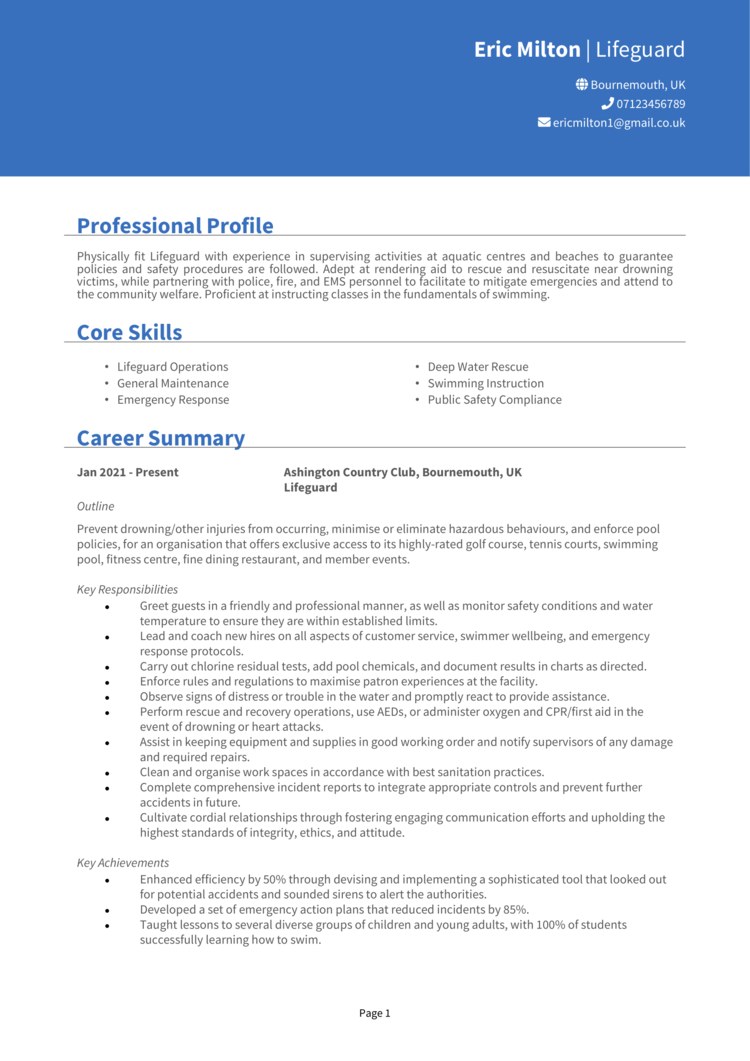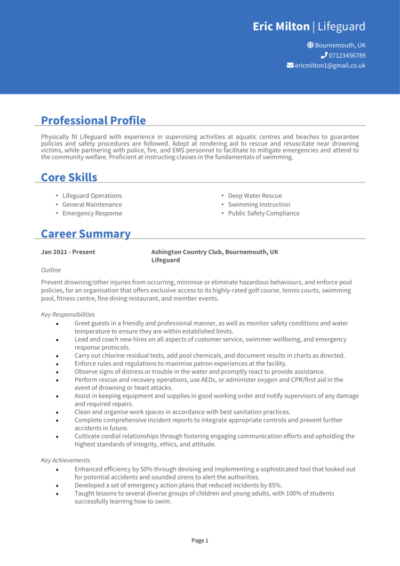You’ve got the vigilance and confidence to keep swimmers safe and situations calm – but first, your CV needs to hold its own under pressure. Lifeguarding might look relaxed from the deck chair, but employers know it’s a serious responsibility that demands focus, quick decision-making, and excellent communication.
This guide (with Lifeguard example CV) will help you present your certifications, experience, and skills clearly – so your application doesn’t just stay afloat, it makes a splash.
Lifeguard CV sample

How to write your Lifeguard CV
Discover how to craft a winning Lifeguard CV that lands interviews with this simple step-by-step guide.
Lifeguards are trusted with people’s safety – and employers want to trust that you’re qualified, capable, and calm under pressure. That trust starts with a strong CV.
This guide will walk you through writing your CV that flexes your experience, showcases your lifesaving certifications, and highlights your readiness to respond.
How to structure and format your Lifeguard CV


As a lifeguard, you’re expected to stay alert and organised – and your CV structure should reflect that. Employers need to quickly see your qualifications, reliability, and any hands-on experience that shows you can keep things under control.
Here’s how your CV should be laid out:
- Name and contact details – Ensure your name and contact details are easily visible at the top. A picture of yourself is optional and depends on the role.
- Profile – Write a short intro that summarises your training, experience, and strengths.
- Core skills – Provide a quick overview of your top skills, like emergency response and crowd control, that show why you’re a great fit.
- Work experience – Outline your career progression in reverse order, emphasising your contributions and successes.
- Education & certifications – Mention school or college history and your lifesaving or first aid qualifications, and other qualifications like a degree on your CV.
- Additional info – You can optionally list any relevant awards, memberships, and hobbies and interests which help to convey your suitability and enthusiasm.
A lifeguard’s job is all about staying alert and in control – so your CV should reflect the same discipline. Use clear section headings to format your content logically, and break up longer blocks of text with bullet points to make key details easy to scan.
Stick to a clear, readable font to keep things professional, and always aim to keep your CV to a maximum of two pages long – just enough to show your skills without letting it drift off course.
How to write a Lifeguard CV profile


Your CV profile is a short, sharp summary of who you are and what you offer. It should reassure employers that you’re qualified and ready to step into a safety-critical role: aim for a thorough overview of the qualities that make you a valuable addition.
Lifeguard CV profile examples
Profile 1
Attentive and safety-conscious Lifeguard with three years of experience supervising swimming pools and beachfronts at public leisure centres. Skilled in monitoring swimmers, enforcing safety rules, and performing first aid and CPR. Qualified in NPLQ and trained in emergency response protocols. Committed to ensuring a safe and enjoyable environment for all visitors.
Profile 2
Responsible Lifeguard with two years of experience working in indoor pool facilities, supporting both recreational and fitness swimming sessions. Experienced in scanning techniques, incident reporting, and responding to minor injuries. Confident communicator with a calm approach to handling emergencies and enforcing poolside regulations.
Profile 3
Vigilant and proactive Lifeguard with over four years of experience across holiday resorts and waterparks. Adept at crowd management, risk assessment, and water rescue procedures. Trained in AED use and first aid, with a strong understanding of safeguarding practices. Dedicated to maintaining high safety standards in fast-paced environments.
Details to put in your Lifeguard CV profile
Here’s some helpful tips on what to add to your CV profile:
- Lifeguard training – Mention the qualification you’ve earned and whether it’s current.
- Work setting experience – State if you’ve worked at pools, beaches, holiday parks, or leisure centres.
- Key traits – Highlight strengths such as alertness, calmness under pressure, and confidence in enforcing rules.
- Teamwork and communication – Briefly refer to how you collaborate with staff or handle the public.
What to include in the core skills section of your CV


Your core CV skills section should offer a clear snapshot of the strengths that make you effective in a lifeguard role. Focus on abilities that show you can monitor, respond, and manage high-pressure situations with professionalism.
These might include observation, rule enforcement, customer service, first aid awareness, water safety protocols, emergency response, or clear communication. Keep the bullet points concise and relevant to the role you’re applying for.
What are the most important skills for a Lifeguard CV?
- Surveillance and Monitoring – Constantly observing swimmers to ensure safety and prevent accidents or dangerous behaviour.
- Emergency Response and Rescue – Reacting quickly to incidents by performing water rescues, CPR, and first aid as needed.
- First Aid and CPR Certification – Applying certified lifesaving techniques to treat injuries, unconsciousness, or drowning situations.
- Pool Safety and Hazard Prevention – Identifying potential risks, enforcing safety rules, and maintaining a safe swimming environment.
- Customer Service and Communication – Interacting professionally with pool users, providing guidance, and addressing concerns.
- Facility Inspection and Maintenance – Conducting regular checks of pool equipment, water quality, and cleanliness.
- Crowd and Conflict Management – Handling large groups safely and resolving disputes calmly and efficiently.
- Weather and Water Condition Awareness – Monitoring environmental conditions in outdoor facilities and adjusting safety measures accordingly.
- Team Coordination and Communication – Collaborating with other lifeguards and staff to ensure effective coverage and emergency readiness.
- Incident Reporting and Documentation – Accurately recording accidents, interventions, and maintenance issues for review and compliance.
How to write a strong work experience section for your CV


Recruiters want to know that you can stay calm, think fast, and take action when it matters. Use this section to show the environments you’ve worked in and how you’ve kept people safe, supported your team, and handled everyday pressures, including some achievements that demonstrate your impact.
Start with your most recent work experience and work backward. Focus on poolside or aquatic roles first, but if you’re early in your career, include anything that shows reliability, maturity, and dealing with the public.
The best way to structure job entries on your CV

- Outline – State where you worked and what kind of environment it was (public pool, resort, etc.).
- Responsibilities – Include key duties like monitoring swimmers, enforcing safety rules, or responding to emergencies. Use action words like “observed,” “responded,” or “assisted.”
- Achievements – Mention anything you handled particularly well – positive feedback, incidents prevented, or emergency situations managed effectively.
Sample jobs for Lifeguards
Lifeguard | HavenCrest Leisure
Outline
Monitored pool safety and supported daily operations for a busy public leisure facility with multiple swimming areas and children’s sessions.
Responsibilities
- Supervised swimming activities, ensuring the safety of all patrons and enforcing pool rules.
- Responded to incidents, administering first aid and completing detailed accident reports.
- Performed daily checks on rescue equipment and maintained cleanliness of the poolside area.
- Supported swim instructors during lessons and assisted with pool setup.
- Provided customer service at reception during quieter periods.
Achievements
- Responded to three emergency incidents with swift and effective action.
- Praised in customer feedback for attentiveness and professionalism.
- Helped improve safety signage around the pool, reducing rule violations.
Lifeguard | CostalSun Holiday Resort
Outline
Oversaw beach and pool safety at a popular family resort, ensuring safe swimming conditions and supporting guest welfare.
Responsibilities
- Monitored swimmers in open water and pool environments during high-season occupancy.
- Implemented red flag warnings and restricted access when weather conditions were unsafe.
- Provided first aid for minor injuries and coordinated emergency services when necessary.
- Liaised with other staff to ensure coordinated safety coverage across resort areas.
- Delivered safety briefings during group activities and watersport sessions.
Achievements
- Helped prevent multiple incidents through early intervention and strong communication.
- Trained two new seasonal lifeguards on protocols and daily routines.
- Recognised for maintaining a calm presence in high-pressure situations.
Lifeguard | Clearwater Sports Complex
Outline
Maintained safety standards and supported aquatic programming at a multi-use sports facility with lap pools and family sessions.
Responsibilities
- Patrolled poolside during recreational and fitness swims, using scanning techniques and safety rotations.
- Performed water rescues during drills and in response to simulated emergencies.
- Assisted in maintaining chemical balance logs and monitoring pool hygiene.
- Reported hazards and maintenance issues promptly to site management.
- Interacted with visitors to promote safe swimming behaviour.
Achievements
- Achieved 100% attendance and punctuality throughout seasonal employment.
- Completed advanced CPR refresher training ahead of schedule.
- Improved safety awareness by recommending signage updates and repositioning first aid kits.
How to list your educational history


Your certifications are vital in lifeguarding, so this section should be easy to scan. Start with the most recent or most relevant, such as your lifeguard training and other education. Real-world experience tends to be more important, however, so keep your education section concise and focus on your job history.
Make sure you include valid qualifications like your NPLQ (or equivalent), First Aid at Work, or CPR training. If you’re currently training or awaiting renewal, state this clearly.
What are the best qualifications for a Lifeguard CV?
- NPLQ (National Pool Lifeguard Qualification) – The standard UK qualification for pool lifeguards.
- RLSS Beach Lifeguard Qualification – Ideal if you’re working at open water or coastal locations.
- First Aid at Work Certificate – Essential for responding to injuries or emergencies.
- AED Training (Automated External Defibrillator) – Important for emergency preparedness.
- Safeguarding Training – Especially relevant if working with children or in family environments.





